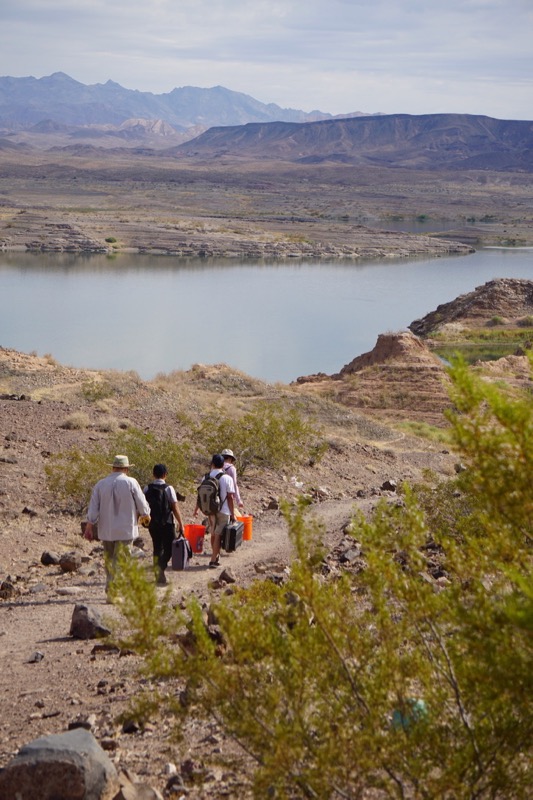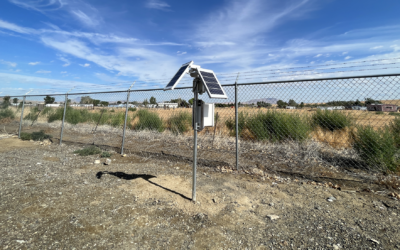Photo: Duane Moser (left) and Xuelian Bai (right) collect filters from the sampling pump to take back to the lab for analysis.
Research on antibiotic resistance genes at DRI
Antibiotic resistance—the ability of bacteria to survive in the presence of antibiotics—is an increasing environmental and public health concern as more antibiotics enter urban waterways and treated wastewater is increasingly used to supplement limited water resources. Current wastewater treatment processes have difficulty removing antibiotics, which also encourages the growth of antibiotic resistance in urban watersheds, such as the Las Vegas Wash.
“Contaminants that are persistent in treated wastewaters that are discarded or reused may lead to health risks for humans,” explains Dr. Xuelian Bai, the principal investigator (PI) of this project that also includes co-PI Dr. Duane Moser and student researcher Rania Eddik-Zein. “The U.S. Centers for Disease Control and Prevention, the World Health Organization, and numerous other global and national agencies recognize antibiotic resistance as a critical challenge.”
The Las Vegas Wash is a unique watershed that is highly affected by anthropogenic activities and flooding during wet seasons.
“A lot of research has been done to monitor chemical contaminants such as nutrients, heavy metals, and organic contaminants, as well as antibiotics in the Las Vegas Wash and Lake Mead,” Bai says. “However, there is still a lack of information on the presence of microbial contaminants and antibiotic resistance genes [ARGs] in the watershed.”
Understanding the presence and abundance of ARGs in this watershed will provide insight into possible antibiotic resistance developing in the wash.
For this project, the researchers will evaluate the occurrence and prevalence of ARGs in the Las Vegas Wash.
“Resistance to antibiotics is encoded in ARGs, which are segments of DNA that enable bacteria to fight antibiotics,” Bai explains. “The major concerns about antibiotic resistance are the tendency of bacteria to share ARGs through horizontal gene transfer and that efforts to kill resistant bacteria, such as UV or chlorine disinfection in wastewater treatment and drinking water facilities, may not remove ARGs.”
The researchers anticipate that the data from this study will provide insight into the prevalence of ARGs in the wash and provide valuable information that can be used to determine water quality and potential human health concerns in southern Nevada.
First, the researchers will take field samples of water and sediment from the Las Vegas Wash to assess the presence of ARGs in an urban wetland ecosystem.
“Municipal wastewater appears to be a significant reservoir of ARGs,” Bai says. “Many studies have detected ARGs at all stages of the municipal wastewater treatment processes.”
Urban water supplies are particularly susceptible to developing antibiotic resistance because of the concentrated quantities of antibiotics that are released when treated municipal wastewater is discharged into the environment.
“Microorganisms in wastewater discharge can transport ARGs to downstream surface waters used for recreation or sources of drinking water, which can lead to human exposure over local, or even global, scales,” Bai explains. “This is a concern in southern Nevada because five major wastewater treatment plants discharge into the Las Vegas Wash. The Las Vegas Wash then discharges into Lake Mead, which is the primary drinking water supply for the Las Vegas Metropolitan Area.”

The DRI research team including (from left) Duane Moser, David Basulto, Hai Pham, and Xuelian Bai carry equipment down to the bank of the Lake Mead, one of several sampling sites along the Las Vegas Wash.
Lake Mead supplies water to millions of residents in the southwestern United States, so identifying potential antibiotic resistance is increasingly important, especially with the drastic population growth in the region. Effluent discharged from wastewater treatment plants, urban runoff, and floodwaters during wet seasons carry sediment, nutrients, and other contaminants to Lake Mead. This generates several water-quality concerns, particularly about the effects of contaminants on aquatic habitats.
“The Las Vegas Wash provides the full continuum of major freshwater aquatic habitats, includingwetlands, flowing water, lake water, and sediment,” Bai explains. “Wetlands, flowing water, and lake water are defined by aerobic conditions and exposure to photosphere influence. However, sediments almost always go anoxic very quickly below the surface, usually within millimeters in eutrophic systems. The fate of antibiotics and the microbial genes that mediate changes in anaerobes have been relatively understudied.”
The researchers anticipate that the field sampling and the lab studies conducted for this project—which include microcosm and microbial community experiments, and DNA analysis—will allow them to specifically identify southern Nevada water issues.
“We will detect and quantify target ARGs in water samples collected upstream and downstream along the Las Vegas Wash, as well as target ARGs in sediment samples collected from the Las Vegas Wash wetlands,” Bai says. “We will also determine the fate and spread of ARGs in the aquatic ecosystems, and assess the effects of elevated antibiotic concentrations on the ecosystem.”
Because evaluating ARGs in surface water and sediment has not been fully studied locally or globally, this project will address local water issues in Nevada and provide useful antibiotic resistance data about urban watersheds that can be used worldwide.
This story was originally written for the Nevada Water Resources Research Institute (NWRRI) July 2019 Newsletter. Success and the dedication to quality research have established DRI’s Division of Hydrologic Sciences (DHS) as the Nevada Water Resources Research Institute (NWRRI) under the Water Resources Research Act of 1984 (as amended). The work conducted through the NWRRI program is supported by the U.S. Geological Survey under Grant/Cooperative Agreement No. G16AP00069.


